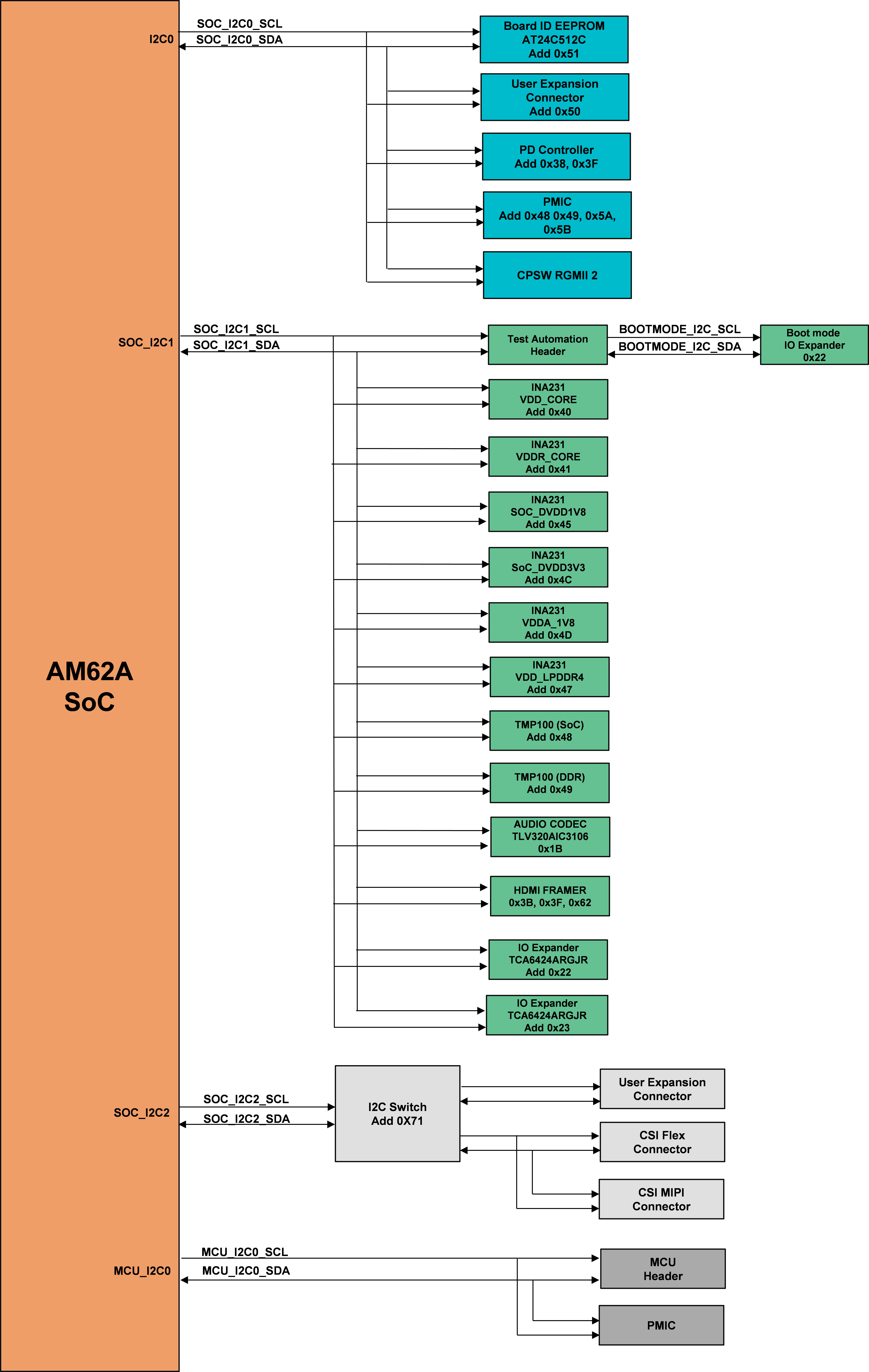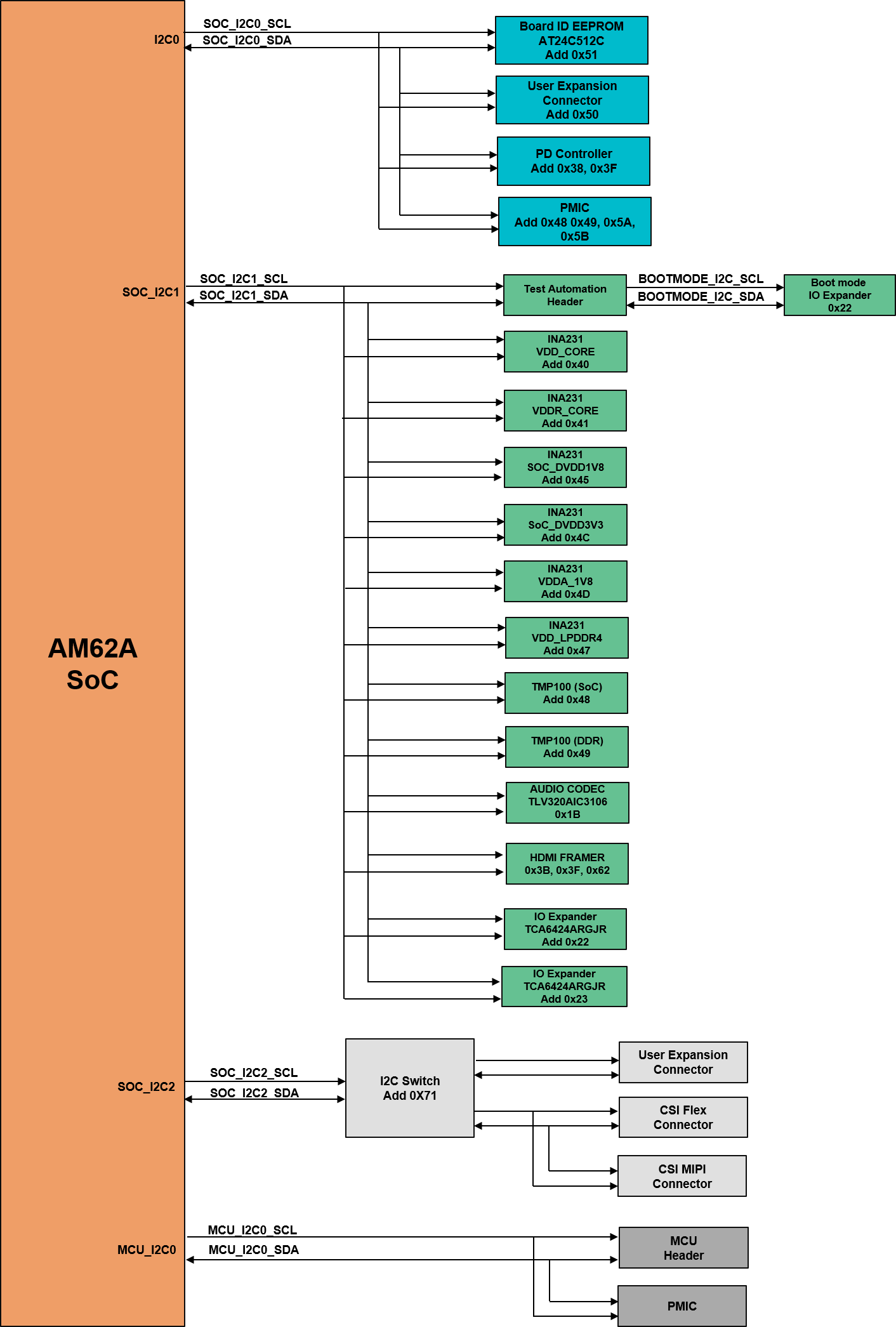SPRUJ66A February 2023 – December 2023
- 1
- Abstract
- Trademarks
- 1EVM Revisions and Assembly Variants
- 2Inside the Box
- 3EMC, EMI, and ESD Compliance
-
4System Description
- 4.1 Key Features
- 4.2 Functional Block Diagram
- 4.3 AM62A Low Power SK EVM Interface Mapping
- 4.4 Power ON/OFF Procedures
- 4.5
Peripheral and Major Component Description
- 4.5.1 Clocking
- 4.5.2 Reset
- 4.5.3 CSI Interface
- 4.5.4 Audio Codec Interface
- 4.5.5 HDMI Display Interface
- 4.5.6 JTAG Interface
- 4.5.7 Test Automation Header
- 4.5.8 UART Interface
- 4.5.9 USB Interface
- 4.5.10 Memory Interfaces
- 4.5.11 Ethernet Interface
- 4.5.12 GPIO Port Expander
- 4.5.13 GPIO Mapping
- 4.5.14 Power
- 4.5.15 AM62A Low Power SK EVM User Setup and Configuration
- 4.5.16 Expansion Headers
- 4.5.17 I2C Address Mapping
- 5Revision History
4.5.17 I2C Address Mapping
There are four I2C interfaces used in SK EVM board:
- SoC_I2C0 Interface: SoC I2C[0] is connected to Board ID EEPROM, User Expansion Connector Header, USB PD controller and PMIC
- SOCI2C1 Interface: SoC I2C[1] is connected to Test Automation Header, Current Monitors (x6), Temperature Sensors (x2), Audio Codec, HDMI Transmitter & GPIO Port Expander (x2).
- SOCI2C2 Interface: SoC I2C[2] is connected to the User Expansion Connector Header and both the CSI Camera connectors (Flex & MIPI).
- MCUI2C0 Interface: MCU I2C[0] is connected to the MCU Header & PMIC.
The image below depicts the I2C tree, and Table 25 below provides the complete I2C address mapping details present on the AM62A Low Power SK EVM.
 Figure 4-32 AM62A LP SK EVM I2C Tree - Rev
E1 and E2
Figure 4-32 AM62A LP SK EVM I2C Tree - Rev
E1 and E2 Figure 4-33 AM62A LP SK EVM I2C Tree - Rev E3 and A
Figure 4-33 AM62A LP SK EVM I2C Tree - Rev E3 and ATable 4-19 I2C Mapping Table
| I2C Port | Device/Function | Part# | I2C Address |
| SoC_I2C0 | Board ID EEPROM | AT24C512C-MAHM-T | 0x51 |
| SoC_I2C0 | User Expansion Connector | <connector interface> | |
| SoC_I2C0 | USB PD Controller | TPS65988DHRSHR | 0x38, 0x3F |
| SoC_I2C0 | PMIC | TPS65931-Q1 | 0x48, 0x49, 0x5A, 0x5B |
| SoC_I2C1 | Test Automation Header | <connector interface> | |
| SoC_I2C1 | Current Monitors | INA231AIYFDR |
0x40, 0x41, 0x4C, 0x45, 0x4D & 0x47 |
| SoC_I2C1 | Temperature Sensors | TMP100NA/3K | 0x48, 0x49 |
| SoC_I2C1 | Audio Codec | TLV320AIC3106IRGZT | 0x1B |
| SoC_I2C1 | HDMI Transmitter | SiI9022ACNU | 0x3B, 0x3F, 0x62 |
| SoC_I2C1 | GPIO Port Expander | TCA6424ARGJR | 0x22, 0x23 |
| SoC_I2C2 | CSI MIPI Connector | <connector interface> | |
| CSI Flex Connector | |||
| SoC_I2C2 | User Expansion Connector | <connector interface> | |
| MCU_I2C0 | PMIC | TPS65931-Q1 | |
| MCU_I2C0 | MCU Header | <connector interface> | |
| Others | |||
| BOOTMODE_I2C | I2C Bootmode Buffer | TCA6424ARGJR | 0x22 |
| BOOTMODE_I2C | Test Automation Header | <connector interface> | |